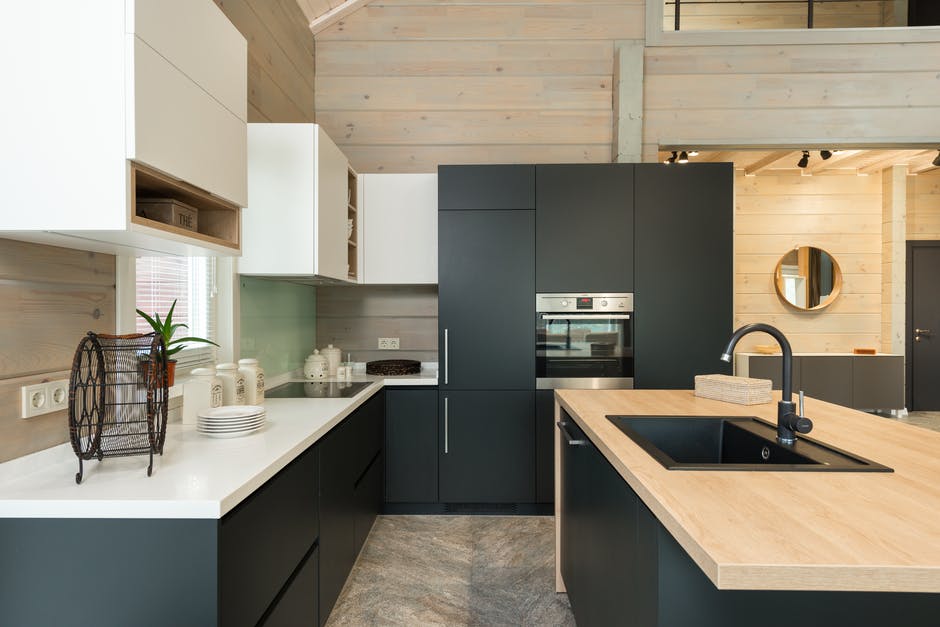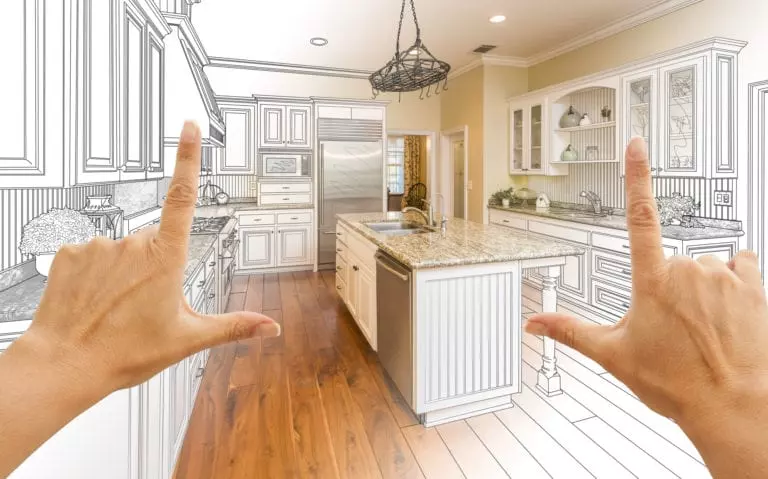
Achieving a Functional Kitchen Layout: Designing for Efficiency and Comfort
Creating a kitchen that’s not only a joy to cook in but also efficient and comfortable requires a thoughtful approach to its layout. The kitchen, often dubbed the heart of the home, is where meals are crafted, where family and friends tend to gather, and where memories are often made. Ensuring this space is as functional as it is beautiful is key to making time spent there enjoyable. This article doesn’t aim to sell you kitchen remodeling services but rather to empower you, our cherished reader, with the knowledge to conceive a well-planned kitchen layout.
Understanding the Work Triangle
The kitchen work triangle is a principle that has been applied in kitchen design for decades. It focuses on creating an efficient layout that minimizes the distance between the three primary work areas: the stove, the sink, and the refrigerator. These form the three points of the “triangle”. A well-implemented work triangle reduces unnecessary movements, making cooking and cleaning more streamlined and less physically taxing. Considerations like ensuring no traffic paths cross through the triangle and keeping the perimeter between these points optimal enhance the functionality.
Fundamental Points of the Work Triangle
- Stove (Cooking Zone): This is where the cooking takes place. It needs easy access to both the sink and the refrigerator, as well as utensils and cooking essentials.
- Sink (Cleaning & Prep Zone): A hub of activity, from cleaning produce to washing dishes, the sink area should have easy access to the trash, dishwasher, and cooking and preparation areas.
- Refrigerator (Storage Zone): This zone should facilitate easy transfer of ingredients to the prep and cooking areas without creating bottlenecks or unnecessary movement across the kitchen.
Tips for Efficiently Implementing the Work Triangle:
- Maintain Perimeter: The sum of the three sides of the triangle should be between 13 feet and 26 feet. Anything more could mean wasted steps, and anything less might create a cramped space.
- Unobstructed Flow: Ensure that the lines of the triangle are not obstructed by islands, trash bins, or any other items that could impede flow and movement between work zones.
- Adapt to Your Space: While traditional triangles imagine equal sides, your specific kitchen layout might demand adjustments to this rule to maximize efficiency.
- Balance Storage: Make sure that each point of the triangle has nearby storage relevant to its function. Pots and pans should be near the stove, waste bins, and cleaning supplies near the sink, and Tupperware and food storage near the refrigerator.
- Sufficient Counterspace: Each point of the triangle should have adequate counter space adjacent to it. This helps in efficient prepping, plating, and organizing of ingredients and utensils.

Small vs. Large Kitchens:
- For Smaller Kitchens: Minimize the distance between the three points to reduce unnecessary steps and make the space feel more navigable and efficient.
- For Larger Kitchens: Consider additional functional zones like a baking station or wet bar, each with its mini-triangle or workflow to prevent any single area from becoming overly extensive or inefficient.
Considering the Modern Kitchen:
With evolving kitchen designs and the advent of additional appliances and gadgets, modern kitchens sometimes implement variations of the traditional work triangle:
- Double Triangle: Larger kitchens might employ two triangles – perhaps one involving a prep sink, oven, and refrigerator, and the other encompassing the stove, main sink, and dishwasher.
- Zones: Incorporating a zoning approach (as touched on in the initial article) alongside the triangle might also benefit larger spaces, ensuring distinct areas for baking, prepping, and even socializing.
Integrating Technological Advances:
Smart kitchens and technology advancements are gradually becoming integral to modern kitchens. While setting up your work triangle, also contemplate:
- Appliance Placement: Situating appliances like microwaves and dishwashers in proximity to the triangle without obstructing its flow.
- Smart Technology: Implementing voice-activated or motion-sensing technology in strategic spots within the triangle to facilitate ease of use and multi-functionality.
Establishing a well-thought-out work triangle doesn’t only pave the way for a more efficient and enjoyable cooking experience but also influences the overall atmosphere and functionality of your kitchen. While the work triangle remains a foundational principle in kitchen design, always tailor these guidelines to best suit your specific space, needs, and personal cooking style.

Zone Planning for Utility and Comfort
Zone planning takes the work triangle a step further, creating designated zones for different activities, such as prepping, cooking, baking, and storage, to optimize workflow and minimize cross-traffic. Key elements to consider in zone planning are:
- Prep Zones: Ensuring adequate counter space for preparing meals, ideally between the sink and stove.
- Cooking Zones: Placing cooking utensils, pots, and pans in close proximity to the stove and oven.
- Baking Zones: Allocating space for baking essentials, perhaps installing a pull-out tray to store baking sheets and other necessary tools.
- Cleaning Zones: Organizing the dishwasher, trash bins, and recycling in a way that facilitates easy cleanup and waste disposal.
Making Zones Work Harmoniously
Once these zones are established, the interconnectedness between them becomes crucial.
- Overlap Mindfully: Understand that some zones will overlap. For instance, the prep and cooking zones might meld somewhat. Ensure this overlap doesn’t create congestion or disorganization.
- Pathways: Construct clear and logical pathways between zones, particularly between high-traffic areas like the prep and cooking zones, and the cooking and serving zones.
- Flexible Design: Acknowledge that the functionality of zones may need to alter slightly based on specific cooking or entertaining needs, keeping designs adaptable.
The exactness of each zone can be tailored according to personal cooking styles, common tasks, and the kitchen’s physical layout. By considering each zone’s unique needs while maintaining a fluid connection between them, kitchen users can experience a thoughtful, productive, and enjoyable culinary space. It’s this strategic design that fosters both efficiency and creativity in the heart of the home.

Safety First: Ensuring a Safe Kitchen Layout
Safety should always be paramount in kitchen design. Considering aspects like ensuring there’s enough space around the oven to open it comfortably, placing the dishwasher close to the sink, and ensuring there’s sufficient space to maneuver safely are pivotal. Moreover, ensuring all zones and paths are free of obstacles to prevent accidental tripping or collisions is vital.
Building a safe kitchen goes beyond merely having a fire extinguisher at the ready. It’s an intrinsic part of design, ensuring that daily operations—from chopping vegetables to navigating hot surfaces—are inherently safeguarded. Here are some focused tips to weave safety into your kitchen layout.
Strategic Appliance Placement:
- Stove Placement: Ensure that the stove is positioned away from high-traffic areas to avoid any accidental burns or spills.
- Microwave Location: Place the microwave at eye level or in a spot where hot contents can be handled safely without needing to reach or bend excessively.
Safe Storage Solutions:
- Store Heavy Items Lower: Ensure heavier items are stored in lower cabinets to avoid injury when retrieving them.
- Childproofing: If children are present, store hazardous items like cleaning agents and sharp tools in upper cabinets or use childproof locks on accessible storage.
Slip-Resistant Flooring:
- Material Choice: Choose flooring materials that provide some resistance to slips, such as textured tiles or matte-finished hardwood.
- Rug Placement: If rugs are used, ensure they have non-slip pads underneath to provide additional stability.
Clear Paths and Ample Space:
- Unobstructed Pathways: Ensure there are clear paths to navigate between different zones, especially between the stove, sink, and refrigerator.
- Sufficient Elbow Room: Provide enough space in cooking and prep areas to ensure safe maneuvering amongst hot pans and sharp objects.
Fire Safety Measures:
- Accessible Fire Extinguisher: Store a fire extinguisher in an easily accessible location, ensuring all household members know its placement and usage.
- Avoiding Clutter: Ensure that cooking areas, especially around the stove, are free from flammable items like paper towels and dishcloths.
Ventilation and Air Quality:
- Effective Ventilation: Incorporate a reliable ventilation system to manage smoke, steam, and airborne grease, ensuring they do not pose respiratory hazards or trigger fire alarms unnecessarily.
- Air Purification: Consider air purifiers if the kitchen space is large and open to other living areas to manage cooking odors and maintain overall air quality.

Illuminating Workspaces:
- Ample Lighting: Ensure that all work zones, especially prep and cooking areas, are well-lit to prevent accidents.
- Strategic Lighting Placement: Place lights strategically to avoid casting shadows on work areas, employing under-cabinet lights if necessary.
Ease of Accessibility:
- Organized Layout: Arrange commonly-used items in easily accessible locations to prevent unnecessary reaching or bending.
- Adjustable Shelving: Implement adjustable shelving in cabinets to cater to all family members’ height and access needs.
Electric Safety:
- Water and Electric Separation: Be mindful of placing electrical outlets far from water sources to prevent any electrical hazards.
- Outlet Covers: Employ covers for unused electrical outlets to safeguard against accidental electrical contact.
Designing with safety in mind necessitates a meticulous approach, ensuring that every aspect from floor to ceiling is scrutinized for potential hazards while maintaining aesthetic and functional appeal. Consequently, the achievement of a safe kitchen layout doesn’t merely protect; it instills confidence and ease into the culinary and social activities that unfold in this pivotal space. It is here, with the knowledge that every possible safeguard is in place, that homeowners can truly unwind and immerse themselves in the joy of cooking and entertaining.

Sustainability and Style: A Timeless Kitchen Aesthetic
The intersection of functionality and aesthetics, particularly in the realm of kitchen design, often takes a route through sustainability. The modern homeowner not only seeks a space that’s utilitarian and visually appealing but also environmentally conscious. The trend towards green living has sparked an evolution in kitchen design, ensuring spaces are crafted not only with precision and beauty but also with a mindful eye toward the planet.
Sustainable Materials:
Opting for sustainable, recycled, or upcycled materials for countertops, cabinets, and flooring speaks volumes about environmental responsibility while also providing a unique and personal aesthetic. Bamboo, for example, is a popular, sustainable alternative for flooring and countertops due to its durability and rapid regeneration.
Energy Efficiency:
Ensuring that appliances, lighting, and HVAC systems are energy-efficient marries functionality with both aesthetic and environmental responsibility. Sleek, modern appliances often come with the added benefit of being designed for optimal energy usage, ensuring you can cook, cool, and light your kitchen in a way that minimizes your ecological footprint.
Natural Light Maximization:
A kitchen design that optimizes the influx of natural light not only creates a warm and inviting space but also reduces the need for artificial lighting, thereby conserving energy. Implementing larger windows, skylights, or strategically placed mirrors to reflect light throughout the space enhances the aesthetic appeal and functionality while being eco-friendly.
Biophilic Design Elements:
Incorporating elements of nature into your kitchen design, such as indoor plants, natural stone, or wooden elements, can create a harmonious and calming environment. This design approach not only enhances the aesthetic appeal but also promotes a healthy living space by improving air quality and fostering a connection with the natural world.
Waste-Reduction Solutions:
Integrating composting systems or waste-separation units into the kitchen layout enables homeowners to manage waste responsibly without sacrificing aesthetic or functional aspects. Hidden trash and recycling compartments within cabinetry or utilizing a corner of the pantry for a composting area ensures waste reduction practices without impeding the visual appeal of the space.
Water Conservation:
Employing fixtures that prioritize water conservation, like low-flow faucets or taps with built-in aerators, ensures that the kitchen’s water usage is optimized without losing out on style. Modern kitchen fixtures often combine elegant design with water-saving technologies, providing the best of both worlds.

Incorporating Aesthetic into Functionality
While ensuring your kitchen is laid out effectively, remember that aesthetic elements can be fused with functional ones. Opting for cabinetry that maximizes storage while aligning with your style, choosing a backsplash that’s both beautiful and easy to clean, and selecting flooring that’s durable, easy to maintain, and complements your design aesthetic, intertwines functionality with visual appeal.
Marrying Functionality and Aesthetic in Kitchen Design
The kitchen, often regarded as the heart of the home, becomes a space where aesthetic appeal and functionality must coalesce to create an environment that is both inviting and practical. The union of these two aspects can manifest in various ways, providing homeowners with a space that doesn’t just meet their cooking needs, but also stands as a delightful visual entity.
Material Choices:
Choosing materials that are both attractive and durable is crucial. For instance, opting for countertops made from quartz or granite provides a sturdy work surface that resists scratches and stains while also offering a sleek and modern aesthetic. Similarly, stainless steel appliances offer a clean and contemporary look while also being recognized for their reliability and longevity.
Color Coordination:
Balancing color palettes is pivotal in achieving a visual appeal without compromising functionality. Opting for a neutral base allows for flexibility in adding pops of color through smaller appliances, utensils, or decor items. Additionally, lighter colors tend to reflect light, enhancing visibility in work areas, thus melding aesthetic with practical illumination of functional spaces.
Open Shelving and Storage Solutions:
Open shelving has become a popular choice in modern kitchens, serving dual purposes of accessibility and display. Homeowners can conveniently reach for frequently used items while also having the opportunity to showcase beautiful dishware, glassware, or decorative items. Implementing pull-out drawers and rotating shelves in cabinets simultaneously enhances the usability and organization of stored items.

Strategic Lighting:
Lighting, when done thoughtfully, elevates the aesthetic while bolstering functionality. Pendant lights over islands or dining areas add a decorative element and provide focused lighting for meal preparation or social activities. Under-cabinet lighting can illuminate countertops effectively, ensuring safety and visibility during culinary activities, while also highlighting backsplash materials and colors.
Ergonomic Design:
Incorporating ergonomic principles into design aspects such as cabinetry handles, faucet designs, and appliance placement ensures ease of use while also opening avenues for aesthetic consistency. For instance, choosing handle designs that are easy to grip and also complement the overall design theme of the kitchen unites functionality with visual appeal.
Harmonizing Styles and Appliances:
Choosing a cohesive style for your kitchen—be it modern, traditional, or transitional—and ensuring that appliances, fixtures, and finishes align with this style creates a seamless aesthetic flow. Stainless steel appliances might perfectly suit a modern, minimalist kitchen, while a vintage-style range might be more fitting for a classic, traditional design.
Integration of Technology:
Modern kitchens increasingly leverage technology. Integrating smart appliances or implementing built-in charging stations for devices can streamline the cooking process and maintain a clutter-free environment. Moreover, the choice of smart appliances can adhere to the overall aesthetic, ensuring a sleek and integrated look.
Incorporating Green Elements:
The aesthetic can also be enriched by infusing natural elements into the design. Introducing indoor plants or herbs not only enhances the visual appeal but also contributes to air purification. Choosing sustainable materials for aspects like flooring or countertops can be both an eco-friendly choice and a fetching design feature.
A well-thought-out design considers both aesthetics and functionality as mutually inclusive. A kitchen that integrates these elements gracefully ensures that homeowners have a space that is a joy to work in and a delight to behold, making the heart of the home beat with a vibrant and enduring rhythm.
We trust that this guide will be a solid foundation in aiding you to plan a kitchen layout that marries efficiency with comfort, creating a space that is a pleasure to cook in and spend time in. Our expertise lies in kitchen remodeling, but, our intention is to provide you with insightful information to guide your kitchen journey, whatever path it may take. If at any stage you do seek professional input or assistance, know that we’re here, ready to turn your kitchen dreams into reality.

